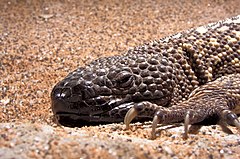Lepidozauromorfy
| Lepidosauromorpha | |
| Benton, 1983 | |
 Heloderma meksykańska | |
| Systematyka | |
| Domena | |
|---|---|
| Królestwo | |
| Typ | |
| Podtyp | |
| Gromada | |
| Podgromada | |
| Infragromada | lepidozauromorfy |
Lepidozauromorfy (Lepidosauromorpha) – infragromada gadów z podgromady Diapsida. Według definicji przedstawionej przez Jacques'a Gauthiera i współpracowników (1988) obejmuje wszystkich przedstawicieli kladu Sauria bliżej spokrewnionych z hatterią i łuskonośnymi niż z archozaurami. Według autorów tak definiowane lepidozauromorfy obejmowałyby Younginiformes, Paliguana whitei, Palaeagama vielhaueri, Saurosternon bainii, Kuehneosauridae, sfenodonty oraz łuskonośne[1]. Późniejsze analizy kladystyczne sugerują jednak, że Younginiformes były diapsydami nie należącymi do Sauria, a tym samym nie mogły być lepidozauromorfami[2][3][4][5][6]. Kwestionowana bywa też przynależność rodzajów Palaeagama, Paliguana i Saurosternon oraz rodziny Kuehneosauridae do lepidozauromorfów – niektóre analizy kladystyczne sugerują, że i one mogły być diapsydami nienależącymi do Sauria[5][6]. Część naukowców zalicza do lepidozauromorfów także zauropterygi[3][4][6], grupy Thalattosauria[7] i Choristodera[6], rodzinę Drepanosauridae[8] oraz żółwie[3][4][6]. Lepidozauromorfy są znane w zapisie kopalnym od permu[9].
Filogeneza
| Lepidosauromorpha |
| ||||||||||||||||||||||||||||||||||||
- Kladogram lepidozauromorfów według Bickelmann, Müllera i Reisza (2009)[10]
| Lepidosauromorpha |
| ||||||||||||||||||||||||||||||||||||||||||||||||||||||
Przypisy
- ↑ a b Jacques Gauthier, Richard Estes, Kevin de Queiroz: A phylogenetic analysis of Lepidosauromorpha. W: R. Estes, G. Pregill (red.): The Phylogenetic Relationships of the Lizard Families. Palo Alto: Stanford University Press, 1988, s. 15–98. (ang.)
- ↑ Michel Laurin. The osteology of a Lower Permian eosuchian from Texas and a review of diapsid phytogeny. „Zoological Journal of the Linnean Society”. 101, s. 59–95, 1991. DOI: 10.1111/j.1096-3642.1991.tb00886.x (ang.).
- ↑ a b c Michael deBraga, Olivier Rieppel. Reptile phylogeny and the interrelationships of turtles. „Zoological Journal of the Linnean Society”. 120, s. 281–354, 1997. DOI: 10.1111/j.1096-3642.1997.tb01280.x (ang.).
- ↑ a b c Olivier Rieppel, Robert R. Reisz. The Origin and Early Evolution of Turtles. „Annual Review of Ecology and Systematics”. 30, s. 1–22, 1999. DOI: 10.1146/annurev.ecolsys.30.1.1 (ang.).
- ↑ a b John Merck. An arboreal radiation of non-saurian diapsids. „Journal of Vertebrate Paleontology”. 23 (Suppl.), s. 78A, 2003 (ang.).
- ↑ a b c d e Johannes Müller: The relationships among diapsid reptiles and the influence of taxon selection. W: Gloria Arratia, Mark V. H. Wilson, Richard Cloutier (red.): Recent Advances in the Origin and Early Radiation of Vertebrates. München: Verlag Dr. Friedrich Pfeil, 2004, s. 379-408.
- ↑ Olivier Rieppel. The systematic status of Hanosaurus hupehensis (Reptilia, Sauropterygia) from the Triassic of China. „Journal of Vertebrate Paleontology”. 18, s. 545–557, 1998 (ang.).
- ↑ Susan E. Evans. An early kuehneosaurid reptile (Reptilia: Diapsida) from the Early Triassic of Poland. „Palaeontologia Polonica”. 65, s. 145–178, 2009 (ang.).
- ↑ Susan E. Evans, Marc E.H. Jones: The Origin, Early History and Diversification of Lepidosauromorph Reptiles. W: Saswati Bandyopadhyay (red.): New Aspects of Mesozoic Biodiversity. Springer Berlin / Heidelberg, 2010, s. 27–44. DOI: 10.1007/978-3-642-10311-7. ISBN 978-3-642-10310-0. (ang.)
- ↑ Constanze Bickelmann, Johannes Müller, Robert R. Reisz. The enigmatic diapsid Acerosodontosaurus piveteaui (Reptilia: Neodiapsida) from the Upper Permian of Madagascar and the paraphyly of “younginiform” reptiles. „Canadian Journal of Earth Sciences”. 46, s. 651–661, 2009. DOI: 10.1139/E09-038 (ang.).
Media użyte na tej stronie
Autor: (of code) -xfi-, Licencja: CC BY-SA 3.0
The Wikispecies logo created by Zephram Stark based on a concept design by Jeremykemp.
Autor: PiccoloNamek, Licencja: CC-BY-SA-3.0
Mexican Beaded Lizard from the local reptile house.

